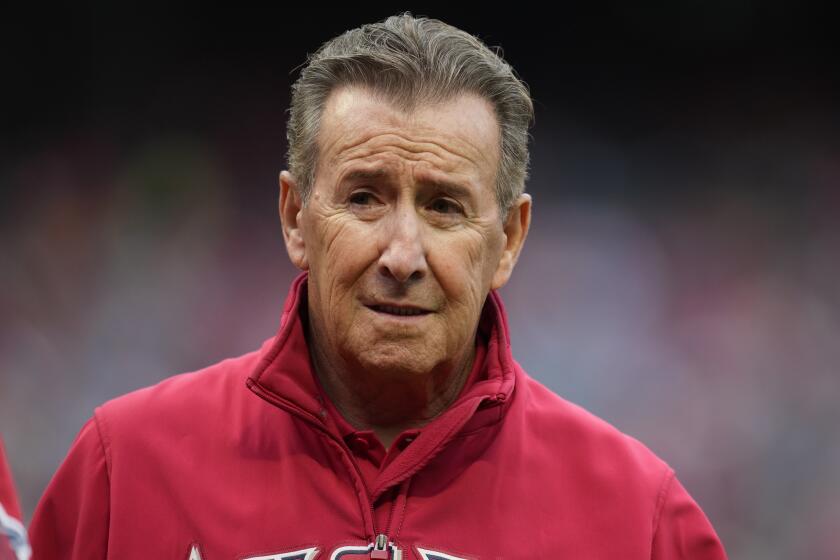Pennant Races Likely to Hang in the Balance
Labor peace doesnât mean total peace for an industry in which distrust and distractions die hard.
For Commissioner Bud Selig, in this first year of a four-year bargaining agreement reached for the first time without a work stoppage, tonightâs season-opening game in Anaheim means his industry has arrived âat one of the most significant moments in history.â
It means, Selig said from Milwaukee, âWe have a chance over the next few months and beyond to leave the focus on the field, expand and improve our marketing and make major strides in moving the game forward, something we havenât always been able to do because of our labor travails.â
The hardened Selig is not Pollyanna, however, and the trail is not without travails.
* The National Labor Relations Board may be forced to resolve a dispute with the new umpiresâ union over deployment of a computerized ball-and-strike analyzing system with which umpires are being forced to conform.
* The playersâ union continues to probe the possibility of collusion by the owners in a depressed salary market, and the union has yet to approve a proposal by which the league that wins the All-Star game would receive home-field advantage in the World Series.
* There are potentially distracting issues involving expanded drug testing, the possible reinstatement of Pete Rose, the search for a new home for the Montreal Expos, the racketeering and mail fraud suit filed by former minority owners of the Expos against Selig and baseball, the heightened concerns over security (which combined with the sluggish economy may make it difficult to recoup the 6.3% attendance drop-off of last year), and the possible sale of the Angels and Dodgers, fogging the freeway focus.
With all of that, however, there is at least one important development that may help keep that focus on the field: The issue of competitive disparity seems to have eased some.
That is not to say that the new bargaining agreement, with its increased revenue sharing, has immediately restored Seligâs faith-and-hope imperative across the entire landscape.
In Pittsburgh, Cleveland, Baltimore, Kansas City, Detroit, San Diego, Tampa Bay and Seligâs own Milwaukee, the new season will open without the faith and hope that accompany a realistic playoff shot.
In varying degrees, each of those teams has begun a long rebuilding process.
At the same time, in varying degrees, more than two-thirds of the 30 teams have a chance to reach the playoffs as a division winner or wild card.
There is three-deep parity at the top of almost every division, particularly in the three National League divisions and the American League West.
âWeâre in the early stages of a new agreement, and I donât want to deal in delusion by saying weâve solved all of our competitive balance problems,â Selig said. âI do think weâve made some progress, and I expect some terrific races.â
How to pick them?
American League
West: 1. Oakland; 2. Angels; 3. Seattle; 4. Texas.
Comment: Maybe Jarrod Washburnâs shoulder, Troy Glausâ wrist and Darren Erstadâs hand will be only brief impediments for the Angels, but uneasy rests the crown in a division where the Aâs have won 205 games in the last two years and retain the Big Three pitching that was most responsible.
Central: 1. Chicago; 2. Minnesota; 3. Cleveland; 4. Kansas City; 5. Detroit.
Comment: The Twins have a legitimate chance to repeat, but the addition of Bartolo Colon and Billy Koch should inspire the White Sox, as long as Jose Valentin and DâAngelo Jimenez can field the ball in the middle of the infield.
East: 1. New York; 2. Boston; 3. Toronto; 4. Baltimore; 5. Tampa Bay.
Comment: The only thing that can stop the Yankees is a bullpen in which Mariano Rivera has been hit by physical problems again, and the Yankees are replacing Mike Stanton and Ramiro Mendoza only two years after replacing Jeff Nelson. Then again, can a bullpen by committee work? The Red Sox will find out.
Wild card: Minnesota. Comment: The Twins get the pleasure of beating up on the Indians, Royals and Tigers while holding their own against the West and East.
National League
West: 1. Arizona; 2. Dodgers; 3. San Francisco; 4. Colorado; 5. San Diego.
Comment: The Diamondbacks at some point will retire to Sun City, but Randy Johnson and Curt Schilling will first have to prove they canât win 40-plus games again.
Central: 1. Houston; 2. St. Louis; 3. Chicago; 4. Cincinnati; 5. Pittsburgh. 6. Milwaukee.
Comment: The eyes of Texas will be on Jeff Kent, but the Astros will need pitching help behind Roy Oswalt and Wade Miller if they are going to win a deep division in which the Cardinals could duplicate their 97 wins, providing closer Jason Isringhausen is sound, which he wasnât in the spring.
East: 1. Philadelphia; 2. Atlanta; 3. New York; 4. Florida; 5. Montreal.
Comment: If Jim Thome and the refurbished Phillies get out of the gate fast, they might not be headed in ending the Bravesâ division dominance, particularly if Mike Hampton is beyond the magic of Atlanta pitching guru Leo Mazzone.
Wild card: Dodgers. Comment: A seemingly healthy Kevin Brown and Darren Dreifort give them impressive rotation depth, and they can be expected to trade a pitcher (Andy Ashby?) for midseason help on offense if in the race.
How did this improved competitiveness occur?
Partially from the impact that the Aâs, Twins, Angels and Giants have made in proving that good management can compensate for restricted revenue. Partially from the introduction of increased revenue sharing in the last labor contract (which will be significantly increased in the new contract).
Said Selig, who had a tough time convincing larger-revenue owners that their generosity wouldnât simply end up in the recipientsâ pockets (a suspicion that wonât go away):
âThe Angels are the No. 1 example of how revenue sharing can work. They would not have reached the World Series and would not have been able to keep their team together if [they hadnât received more than $40 million in the last six years]. Whether they should be a recipient club in that market is another story.â
The Angels have been a recipient club based on revenue that has generally put them in or near the bottom half of the 30 teams.
That may change given the expected attendance and marketing boom that begins tonight -- a significant moment in history for the club, if not Seligâs industry.
More to Read
Go beyond the scoreboard
Get the latest on L.A.'s teams in the daily Sports Report newsletter.
You may occasionally receive promotional content from the Los Angeles Times.







